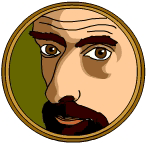MC Escher - Lithographer
Created | Updated Mar 5, 2009

Maurits Cornelis Escher was born in 1898 in Leeuwarden in the Netherlands. He studied graphic design at the School of Architecture and Ornamental Design in Haarlem, lived in Italy for ten years, from 1922, and visited many places both in that country and in Spain as part of his further studies. He lived also for a time in Switzerland and Belgium before settling back in Baarn in his native Holland in 1941. He died in 1972, at the age of 73.
Escher was not a painter, and indeed did not even consider himself an artist. His works are primarily lithographs or woodcuts, and are therefore mainly monochromatic. Although he produced many pieces of purely representative art, including Dewdrop, Three Worlds, and Castrovalva1 , Escher is best known for works embodying his greatest inspirations - tessellation and impossible figures.
Tessellation
Tessellation means simply dividing a two dimensional surface into interlocking shapes. For instance, equilateral triangles interlock perfectly - ie, they tessellate - and can cover a flat surface with no gaps between them. The same is true of squares and hexagons, but of no other regular polygon.
Escher's interest in tessellations began early - his woodcut Eight Heads dates from 1922, when he was still in college. He undertook a trip to the The Alhambra, a Moorish citadel in Spain, and was inspired by the complex tessellating patterns with which the Muslim artists had decorated the building. In fact, he spoke of tessellation as 'the richest source of inspiration I have ever tapped'. Inspiring as these complex interlocking patterns were, Islam prohibited representational art, and Escher saw enormous potential for figurative tessellations, ie, interlocking pictures of creatures or objects. Not having a mathematical background, he proceeded to develop independently the rules of tessellation for himself, and produced many fascinating works based on this principle.
Escher's tessellations range from relatively simple divisions of the plane into repeating identical patterns representing lizards or fish, through more complex patterns where the interlocking shapes are different, representing animals, birds, people and objects; patterns where the shapes gradually shrink to nothing at the limits of the drawing, to what is possibly the pinnacle of his tessellation work, Metamorphose III.
Metamorphose III
This large work was commissioned for the Kerkplein Post Office, The Hague, in 1968. A tour de force 19.5cm high and 7 metres long, it is very similar in content to his earlier Metamorphose II, with a few additions. The viewer is drawn along past the title to a pattern of squares, which become interlocking flowers complete with bees, before returning to a pattern of squares. The squares become hexagons, then interlocking lizards, then back to hexagons which become honeycombs with bees again. The bees take flight and interlock with fish, which in turn interlock with birds, which interlock with sailing boats. The boats become sea in which more fish are swimming. The fish become the spaces between horses, and the horses the spaces between birds, which become triangles, which become winged envelopes2, to triangles which become birds, which interlock with other birds, becoming cubes, becoming a town by a coast, which becomes a chessboard, which becomes some squares which lead back to the title.
Impossible Figures
Escher's other major source of inspiration was impossible figures - that is to say, structures which although they can be drawn in two dimensions, cannot exist in three dimensions. Examples of such work include:
Belvedere in which the upper storey of an Italianate building is supported by pillars which connect to the lower in impossible ways
Waterfall in which a waterfall drives a waterwheel, and is apparently channelled down and away to arrive paradoxically back at the top of the waterfall.
Ascending and Descending in which the roof of a square tower is a staircase which joins itself. A group of figures heading clockwise appear to be eternally climbing the stairs, while another group of figures head ever downwards in the opposite direction.
Relativity - in which three worlds with three different gravities at 90 degrees to each other coexist in a single space. This print was the inspiration for a sequence in the Jim Henson film Labyrinth, starring David Bowie and recent Oscar-winner Jennifer Connelly.
Frustrated Genius
Escher's achievements in representing the paradoxical were unprecedented and remain unparalleled. However, despite this, he remained unsatisfied. In a haunting comment, which gives some small hint of what it must have been like to have had his talent, he once said:
If only you knew the things I have seen in the darkness of the night... at times I have been nearly demented with a wretchedness at being unable to express these things in visual terms. In comparison with these thoughts, every single print is a failure, and reflects not even a fraction of what might have been.
Links
There is an abundance of Escher material on the web. You can see most of Escher's most famous works, including all those mentioned above, here at the Escher Art Collection.

